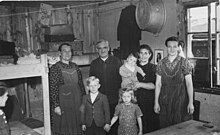Moschendorf camp

The Moschendorf camp in the Moschendorf district of the city of Hof (Saale) was built as a satellite camp and, after the end of the Second World War, was used and expanded as a refugee and border transit camp .
Forced labor camp, Hof-Moschendorf subcamp
As early as 1941 there was a barrack camp for Eastern European forced laborers on the grounds of the Moschendorf porcelain factory . From September 3, 1944, it was used as a camp by concentration camp prisoners, initially as a sub-camp of the Dachau concentration camp , then as a sub-camp of the Flossenbürg concentration camp . The approximately one hundred prisoners repaired captured weapons for the SS . In March 1945 there were 33 Germans, 20 Poles, 14 Russians and other prisoners from ten nations in the camp, a total of 102 people, only one of them Jews . The camp manager was SS-Sturmbannführer Ludwig Bauer from Neustadt near Coburg .
Four deaths are documented, two of the forced laborers died of pulmonary tuberculosis and one in an accident at work. The fourth, a Yugoslav, was hanged in front of the other inmates for making shoe soles out of belts.
A few days before the American troops marched in in 1945, the camp was disbanded. A significant number of the prisoners were able to flee, around 60 people were deported to the Dachau concentration camp . This resulted in deaths and murders (the magnitude of the number is missing). On April 14, 1945 the camp was liberated by the American forces .
In 1967 there was an investigation into the killing of the prisoner, but it was discontinued in 1973.
Refugee and transit camp in Moschendorf
The camp, which was located directly on the Hof – Regensburg railway line between the Moschendorf and Hof Hauptbahnhof railway stations , was used after 1945 as a transit camp for expellees and war returnees . After the expansion in 1946, the camp could accommodate 5,000 people, including refugees from the Soviet occupation zone, which later became the GDR .
There were extensive facilities to take care of the refugees and returnees. It had its own hospital. Kindergarten and school were set up for the children. There was a Catholic church room and contact with the nearby evangelical Church of the Resurrection .
In April 1957, the Hof-Moschendorf refugee camp was dissolved. The demolition of the barracks dragged on until spring 1962. At the site of the former warehouse there is now a factory of the Hof textile group .
A memorial on Wunsiedler Strasse commemorates the former camp with the following inscription:
- From 1945 to 1957, the Moschendorf border transit and mass camp was the gateway to freedom for hundreds of thousands of German prisoners of war, civil prisoners and expellees from the Second World War who came from the vastness of the East. This site is intended to warn people to condemn violence, to renounce hatred, to serve reconciliation and to keep peace in freedom.
The monument by the sculptor Fritz Theilmann was erected in 1980 by the Association of Returnees (Regional Association Bavaria and District Association Hof) with the support of the city of Hof (Saale) .
literature
- Wolfgang Benz , Barbara Distel (ed.): Place of Terror 4: History of the National Socialist Concentration Camps . Vol. 4th 1st edition, Beck, ISBN 978-3-406-52964-1
- Jürgen Greim: In a new home - refugees and displaced persons in the Hof-Münchberg-Naila-Rehau area. District Office Hof (Ed.), Hoermann Verlag, Hof (Saale) 1990, ISBN 3-88267-035-5
Web links
- The Moschendorf porcelain factory on whose lease a warehouse was built in 1941.
- On the history of the camp ( Memento of December 30, 2005 in the Internet Archive ) (PDF; 464 kB) Info sheet of the SPD local association Moschendorf, 3rd year 1/05, pp. 2–3
- Transit and mass storage facility Hof-Moschendorf (numbers of affected persons at wiki-de.genealogy.net or dfxnet.de/spd/hof-stadt/moschendorf)
Coordinates: 50 ° 17 '39 " N , 11 ° 55' 42" E
